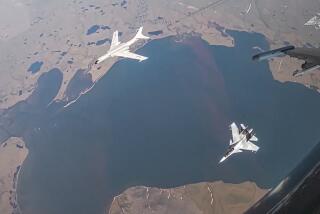Pilots Change Their Missions in Midair
ABOARD THE USS CARL VINSON IN THE NORTHERN ARABIAN SEA--In an intricate hunt for tanks and weapons hidden in the relentless Afghan landscape, U.S. fighter pilots in recent days have increasingly picked out their own targets in midair, then asked permission to drop bombs.
The new fluidity of the bombing raids is a departure from the Afghan air war’s early days, when the United States was intent on winning control of the skies. In early attacks, pilots demolished massive, immobile targets such as airports and grounded fleets of military jets.
But now, 11 days into the bombing, the bigger fixed targets have been blown to rubble. Pilots are left scanning the hills for elusive, mobile equipment and troops.
“Hopefully, there aren’t as many targets, but then, maybe they’re getting better at hiding them,” said Navy Capt. T.C. Bennett, who is in charge of this aircraft carrier’s pilots. “The mountainous terrain lends itself to that.”
The bombing attacks have proved less than perfect: On Tuesday, U.S. strikes reportedly hit warehouses used by the International Committee of the Red Cross in Kabul, the Afghan capital. Three days earlier, a U.S. bomb intended for a military helicopter in Kabul crashed into a row of residential buildings a mile away, reportedly killing four civilians.
Still, resting in a lounge aboard the Vinson, pilots insisted that their bombs are hitting the proper targets.
“From the movies, people think we’re up there with our hair on fire, screaming, ‘Yahoo!’ ” said a 34-year-old pilot who calls himself Dirty. “Really, it’s more of an administrative drill. I’m almost on autopilot.”
In search of smaller targets, many of the pilots are changing their missions in midair. On Sunday, Bennett was ordered to find and destroy antiaircraft weapons reportedly hidden in the foothills outside a city in southern Afghanistan. When he arrived, the guns were nowhere to be seen, so he called for new orders. None came, so Bennett headed back to the ship without dropping a bomb.
When pilots catch sight of a likely target--a grouping of tanks, for example--they can radio for permission to attack. “Then we wait for them to say, ‘Yeah, baby,’ or ‘Uh-uh,’ ” Bennett said. A radio response from a network spanning Saudi Arabia, Florida and Washington, D.C., can come back in five minutes, or can take hours.
“We are in a pinpoint war here,” Bennett said. “It is absolutely taboo--taboo--to be dropping on something if you don’t know what you’re dropping on.”
Fighter pilots based on the Vinson have been cruising over Afghanistan to shoot reconnaissance photographs of roads, communication networks and suspected military bases.
Scanning for targets is tricky work: The notoriously brutal countryside is pocked with deep caves and shadowed by mountains. Even the farms, the pilots say, are just a deeper shade of brown.
In Operation Desert Storm, said Rear Adm. Thomas E. Zelibor, the battle group commander, “we weren’t trying to find people in caves and things like that, all spread out.”
Zelibor, saying the U.S. has air superiority, alluded to the next stage in the conflict. “We’re focused on preparing the battlefield,” he said. “We want to make sure we have a clear area.”
If the targets are shrinking, so are the flights. Last week’s arduous, seven-hour treks have been replaced by snappy, two-hour missions. That means many pilots are flying off twice a day, but they say they don’t mind.
Before the attacks began, nobody had spent more than a few hours flying an F/A-18. When the strenuous Afghan raids began, the pilots complained bitterly of bruised buttocks and late-night landings.
Every pilot and jet on the Vinson has been dispatched to Afghanistan at least once in recent days. There were two breaks: Last Thursday, a thick dust storm scrambled the radar and stilled the attacks. The next day, the attacks were paused in observance of the Islamic day of prayer.
Since then, the flurry of raids has been constant and exhausting. So dizzying, in fact, that a 30-year-old pilot named Corie can’t remember what target he was heading out to bomb the night his jet drew fire from the Afghan countryside.
“That night . . . “ the St. Louis native said, pausing. “I can’t remember. There are a lot of things to think about.
“You’ve got to take it all in.”
More to Read
Sign up for Essential California
The most important California stories and recommendations in your inbox every morning.
You may occasionally receive promotional content from the Los Angeles Times.










